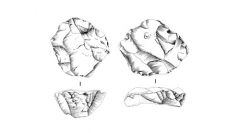

 Comptes Rendus Palevol
4 (4) - Pages 359-367
Comptes Rendus Palevol
4 (4) - Pages 359-367In prehistoric archaeology, raw material origin is studied through a cartographic approach of siliceous formations. This proceeding enhances the flint stone deposits limited by their current accessibility. The recordings are restricted because of the topography or environmental conditions that reject any exhaustive approach. Moreover, this approach does not provide these siliceous formations with any stratigraphic context. It does not allow us to understand the geologic causalities concerning flint faciologic variability. Our researches considered three methodological aspects: exhaustive stratigraphic recognition of siliceous irregularities inside a geological stage, geomorphologic study concerning their accessibility modalities and petrographic determination of geological and archaeological elements. This subject is illustrated through the analysis of two archaeological Palaeolithic assemblages (Combe Joubert and Les Craux).
Lower and Middle Palaeolithic, Oligocene flints, gitology, petrography, geology, geomorphology